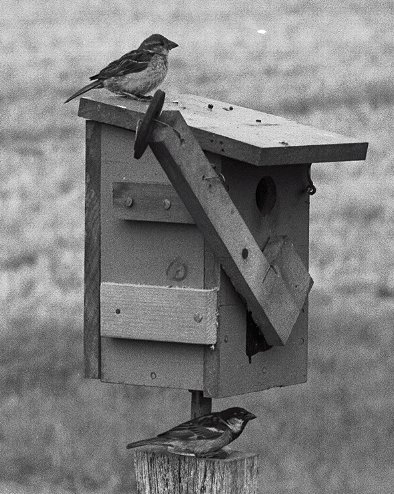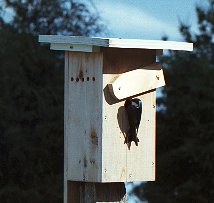

 Remote release traps have been fitted to some of my video cam nest boxes for catching house
sparrows and starlings the moment they enter a box. I can monitor the nest box from my office
or workshop and remotely close the entrance cover at the push of a button. This method can be
used to catch a house sparrow or starling the first time it is seen in the box, rather than waiting for it to actually claim the box so an automatic trap can be used. Also, non-target species are not trapped, as is the case with automatic traps. However, if you are using one of the commercially available automatic hole cover traps, don't be afraid to trap your bluebirds as long as you quickly release them. Many people have reported that their bluebirds returned to the box soon after being caught, and, in fact have been caught twice in the same day. This suggests that the experience didn't upset them very much. However, it is obviously better to avoid trapping the bird you wish to nest in the box.
Remote release traps have been fitted to some of my video cam nest boxes for catching house
sparrows and starlings the moment they enter a box. I can monitor the nest box from my office
or workshop and remotely close the entrance cover at the push of a button. This method can be
used to catch a house sparrow or starling the first time it is seen in the box, rather than waiting for it to actually claim the box so an automatic trap can be used. Also, non-target species are not trapped, as is the case with automatic traps. However, if you are using one of the commercially available automatic hole cover traps, don't be afraid to trap your bluebirds as long as you quickly release them. Many people have reported that their bluebirds returned to the box soon after being caught, and, in fact have been caught twice in the same day. This suggests that the experience didn't upset them very much. However, it is obviously better to avoid trapping the bird you wish to nest in the box.
A wooden external pivoting hole cover is fitted to the front of the nest box and left in place throughout the nesting season. The solenoid is mounted on the side of the box only when trapping is anticipated. While the wood stick across the front of the box seems obviously strange to a human, none of the birds, including starlings and house sparrows have shown any concern. Perhaps this is because it is made of wood, or, perhaps because it is left in place and not added at the time of trapping. Starlings quickly learn to avoid my metal internal hole cover traps on the flicker boxes once one of them is caught. They peer into the entrance, look down at the wire bail, and leave.
 On large kestrel and flicker boxes, the hole cover pivots downward, but, on some small boxes, there is not enough room between the entrance and the overhanging roof, so the hole cover arm is made longer, extending out to the side of the box, and is counterweighted so it rises up to cover the hole when tripped. Birds like this extra perch on the side of the box throughout the nesting season. When the solenoid is not in place, a pin secures the pivoting arm so there is no chance that it will trip accidentally.
On large kestrel and flicker boxes, the hole cover pivots downward, but, on some small boxes, there is not enough room between the entrance and the overhanging roof, so the hole cover arm is made longer, extending out to the side of the box, and is counterweighted so it rises up to cover the hole when tripped. Birds like this extra perch on the side of the box throughout the nesting season. When the solenoid is not in place, a pin secures the pivoting arm so there is no chance that it will trip accidentally.
The solenoid is powered by either a car battery (if I am watching the box from a vehicle) or the same 12 volt DC wall transformer that I use for the video cameras, if I am monitoring the box via video from my office or workshop. In theory, using the video monitor while working should save time, but, catching the sparrow or starling entering the nest box requires constant attention. Somewhere in our attic is an infrared beam device I used years ago to count the number of visits by bluebirds to their nest box. This, connected to a buzzer instead of the counter and chart recorder, would make an excellent alarm to alert me to check the monitor each time a bird landed at the entrance.
Use of nest boxes and nest box traps by starlings and house sparrows
| barn owl | American kestrel | purple martin | barn swallow | Eastern bluebird |
| tufted titmouse | Eastern phoebe | yellow shafted flicker | tree swallow | chimney swift |
| house wren | big brown bat | Carolina wren | brown thrasher | catbird |
| Eastern wood-pewee | cedar waxwing | Northern mockingbird | Turkey vulture | |